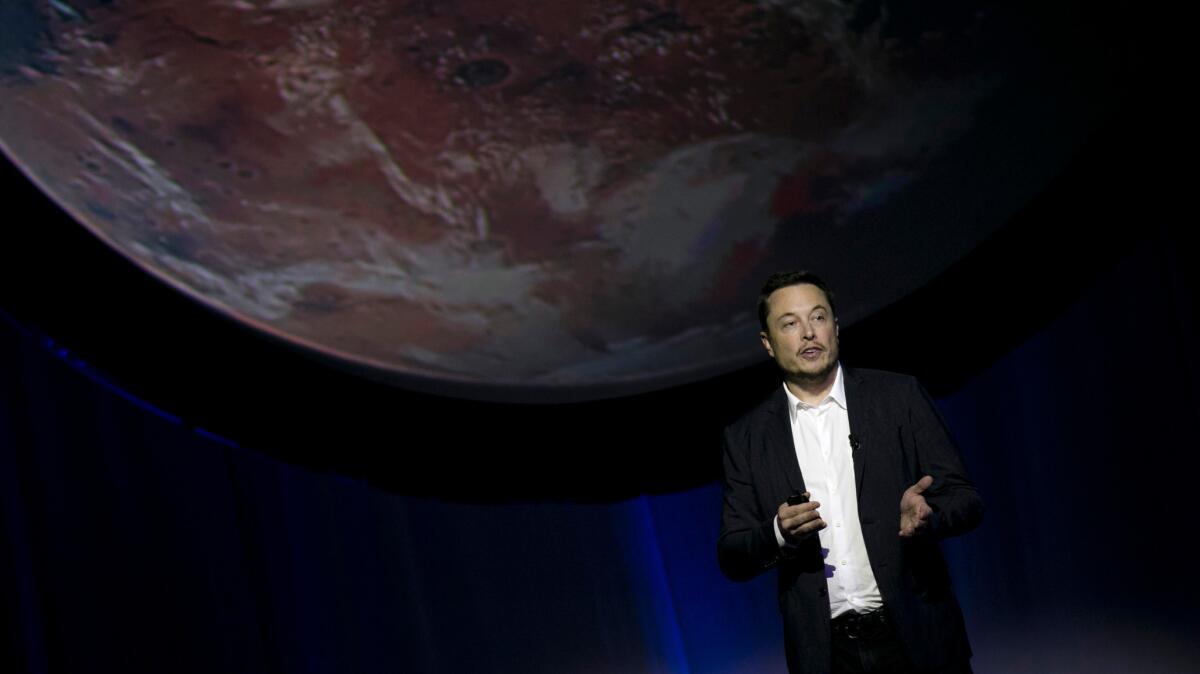Four stiff challenges Elon Musk will have to overcome to turn his Mars dream into reality

- Share via
SpaceX Chief Executive Elon Musk has finally laid out his plans to eventually transport up to a million people to colonize Mars. But there are more than a few hurdles he’ll have to clear first.
In a speech Tuesday at the International Astronautical Congress in Guadalajara, Mexico, Musk presented a grand vision — massive rockets launching a fleet of 1,000 spaceships that would each carry about 100 people to Mars.
The huge rocket boosters would be reusable, barreling back to Earth after hoisting the spaceships into a “parking orbit,” and then returning three or four times with propellant tankers to refuel the ships for their long voyage.
Once on Mars, Musk plans to develop a propellant farm to harvest the methane and liquid oxygen necessary to power the spacecraft for the journey home.
The challenges are immense, says Richard Wirz, director of the UCLA Plasma and Space Propulsion Lab, but also “inspiring.”
“We need people out there like Elon Musk that are inspiring the next generation of engineers,” he said. “It’s hard to get students into STEM fields if we’re constantly saying, ‘No you can’t do that.’ Let’s keep letting visionaries like this lay out blueprints, and then let’s see what we can do.”
Here are some of the challenges that lie ahead:
Funding
Musk acknowledged this difficulty himself in his Tuesday speech, pointedly saying, “Obviously, it will be a challenge to fund this endeavor.”
So far, he estimated that SpaceX has dedicated less than 5% of its resources to the interplanetary transport system, amounting to a “few tens of millions of dollars.”
In a year and a half to two years, once other projects wrap up, he said he hoped to have most of SpaceX’s engineering team working on the Mars mission, and devote $300 million a year to the project.
Musk estimated that SpaceX would have to invest $10 billion to develop the interplanetary transport system.
He said SpaceX expects to generate “pretty decent” revenue from satellite launches and the Hawthorne company’s resupply missions for NASA for the International Space Station.
He added that the “main reason” he was “personally accumulating assets” was to fund this endeavor, and that there were people in the private sector who were interested in funding a Mars base.
But he said the project will ultimately require a public/private partnership.
NASA is already developing the Space Launch System, a massive rocket that the agency plans to send to an asteroid in the mid-2020s and to Mars in the 2030s. But Congress has not yet committed the financial resources to enable the trip.
Size of the rocket
The rocket booster for the interplanetary transport system will measure about 39 feet in diameter and stand 254 feet tall.
When stacked with the spaceship, the combined height will be about 400 feet — taller than the Saturn V rocket that carried astronauts to the moon in the 1970s. The SpaceX rocket would also have nearly four times as much thrust. The Saturn V is the most powerful rocket ever used.
The SpaceX Mars rocket will be powered by 42 Raptor engines, which runs on methane and liquid oxygen. The large number of engines provides for redundancy, meaning that if a few engines fail, there are enough others to keep it going.
But the size and power of the rocket will be a challenge, Wirz said.
“The more engines you employ, the more complexity,” he said.
A propellant farm on Mars
The idea of propellant production on the Red Planet is key to Musk’s plans to reduce the cost of going to Mars.
Musk said he wanted to use the carbon dioxide in Mars’ atmosphere along with the oxygen from the water ice on the planet to create a propellant depot on Mars to refuel the spaceships after they arrive.
But he didn’t give any details of how the fuel would be manufactured. At this point, no one has figured out how to do it, said David Barnhart, director of the USC Space Engineering Research Center in an interview Tuesday.
Also unclear: how to supply the factory with a reliable source of water. Water has been found flowing intermittently under the Martian surface and in solid form in the northern ice cap, but it will be difficult to find enough of it, not to mention processing it into fuel, Wirz said.
Keeping humans safe on the way to and on Mars
Musk gave few details on what humans would do once they get to Mars and how they will be protected from the high-radiation environment they will encounter on the journey and after arrival.
During his speech, Musk said there will be “some risk” of radiation, but “it’s not deadly.” He said there would need to be “some shielding,” particularly if there was a solar flare or a solar storm. He mentioned that an artificial magnetic field could be constructed over time to deflect high-energy particles, but gave no details.
Wirz said this was an important aspect of any long-term settlement plans.
“The radiation environment is one of those things that humans aren’t built for,” he said.
How the colonists will breathe on Mars is less of an issue, Wirz said. The International Space Station has already demonstrated the successful use of technology that turns carbon dioxide into oxygen.
For more business news, follow me @smasunaga
ALSO
Elon Musk's Mars plan involves giant reusable rockets, spaceships flying 100 people
SpaceX test fires Raptor engine for rocket that might one day take people to Mars
SpaceX explosion: 'Large breach' took place in helium system in second stage of rocket
Inside the business of entertainment
The Wide Shot brings you news, analysis and insights on everything from streaming wars to production — and what it all means for the future.
You may occasionally receive promotional content from the Los Angeles Times.








